Newsletter: Painter Raul Guerrero skewers American history in wry solo show at David Kordansky Gallery
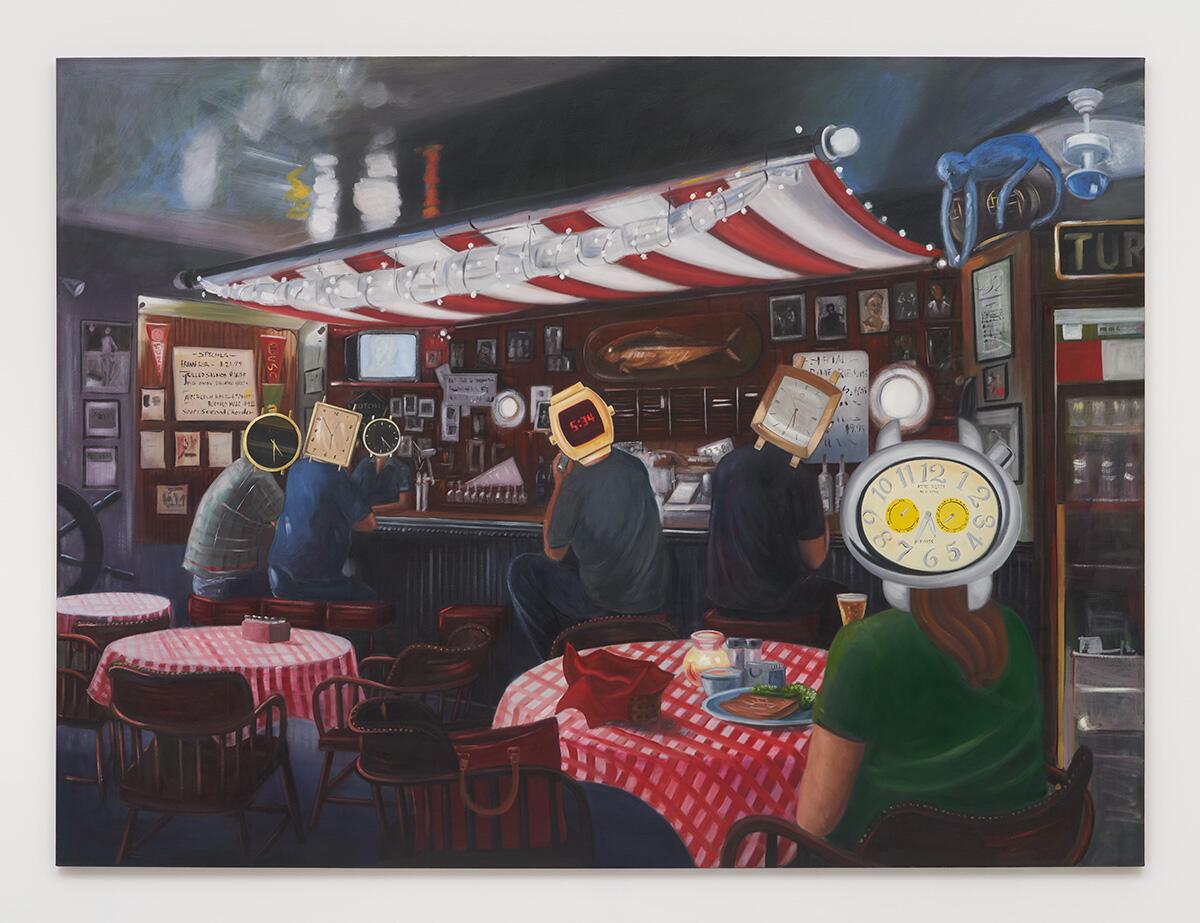
- Share via
If the heat has you feeling like a spent dishrag, then get on up by streaming the absolutely joyous “Summer of Soul” on Hulu. It’s got music. It’s got moves. It’s got mounds of late ‘60s polyester. I’m Carolina A. Miranda, art and urban design columnist at the Los Angeles Times, and I’m here with all the cultural essentials:
Western history through a distortion lens
In Raul Guerrero‘s solo exhibition at David Kordansky Gallery, you start at the end. Specifically with the word “Fin,” which is painted in the undulating style of a cinematic end credit over an image of a stagecoach in the middle of a violent robbery. A man lies prone as if wounded. A woman pleads with a cowboy on horseback. Assorted bandits go about their ransacking.
The painting may depict an end of sorts, but in many ways, it’s a beginning — an excellent primer on Guerrero’s attitudes toward his subjects. The piece, “Ataque de Una Diligencia,” 1995-2021, marries his eclectic interests: cinema, colonial history and the ways in which culture is mediated. “That’s how we understand our history — as cinematic,” says Guerrero via telephone. “We know it through media.”
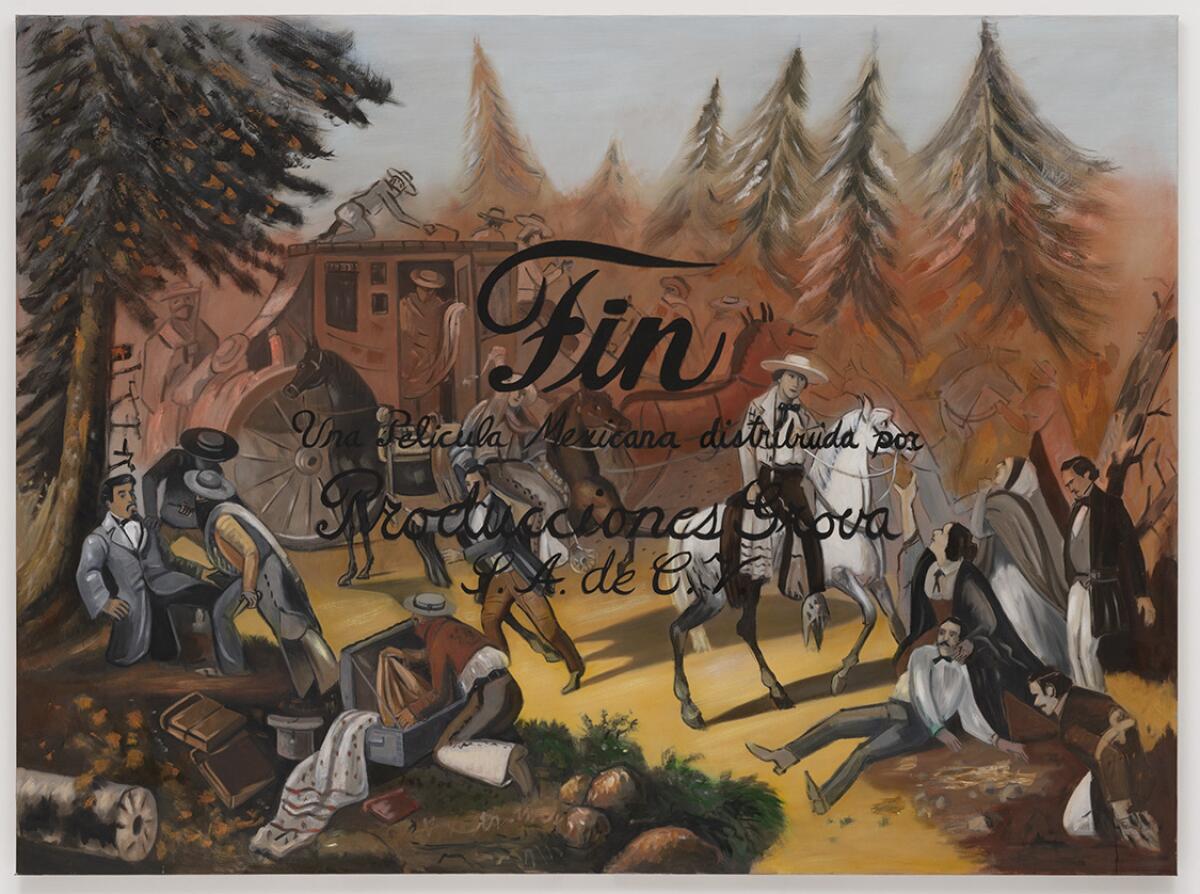
As with much of his work, it features a rich color palette and comes pre-loaded with a dose of absurdity. (The handsome lettering of the words hang like an elegant scrim over a scene of pure chaos.) The painting contains a mournful aspect too. As far as the European settlement of the West was concerned, episodes such as this did spell an end of sorts. But it wasn’t for the settlers; it was for the Indigenous cultures who lived in their path.
Guerrero’s one-man show, “Fata Morgana,” at Kordansky through the end of the month, offers a generous sampling of the sorts of images and ideas that drive this long-time Southern California painter’s work.
Born in Brawley, Guerrero grew up in National City and lives in San Diego. His father’s family was Indigenous — Tarahumara or Apache, he says — while his mother’s relatives were descended from Spain and France. He occupied a hybrid reality in more ways than one: Like a lot of Mexican Americans who grow up along the border, he spent his life traveling back and forth between Mexico and the United States and inhabiting a territory (Southern California) where those realities overlap in myriad ways.
“You are going through these paradigm shifts and these different reality shifts,” he says. “That inspires the imagination, simply because you are living in a shifted situation.”
Make the most of L.A.
Get our guide to events and happenings in the SoCal arts scene. In your inbox once a week.
You may occasionally receive promotional content from the Los Angeles Times.
Now 75, Guerrero has never settled into one reality, and the show at Kordansky — which features paintings from various stages of his career — reflects that. This includes paintings of food, bar interiors, invented historical scenes, canvases inspired by filmmaking and his appropriations of romantic 19th century paintings of Native Americans.
One series was inspired by his journeys through South Dakota in the 1990s. Driving through the Pine Ridge Reservation, he hung out with a group of Indigenous women who had car trouble. This was followed by his own automative break-down in the Black Hills where he ended up in a joint worthy of a Hollywood Western.
“The first night I walk into this bar/restaurant/saloon and it’s 1990 and my hair is dark and I’m Mexican ... and I thought, I’m going to get killed,” he says. “These men are all at the bar and they all have long hair and beards and they look like they are straight out of a movie. I realized that everything I knew about this place was through media — movies, television.”
In the wake of that journey, he placed some of those faces in paintings inspired by the history of Western settlement, but also by Westerns. There are barroom standoffs and “Wanted” posters and Gen. George Custer getting shot with arrows. All of this is delivered in a deeply saturated color palette that Guerrero describes as “Looney Tunes.”
It’s an interesting parallel. The ways in which U.S. history is recounted can sometimes feel like a cartoon.
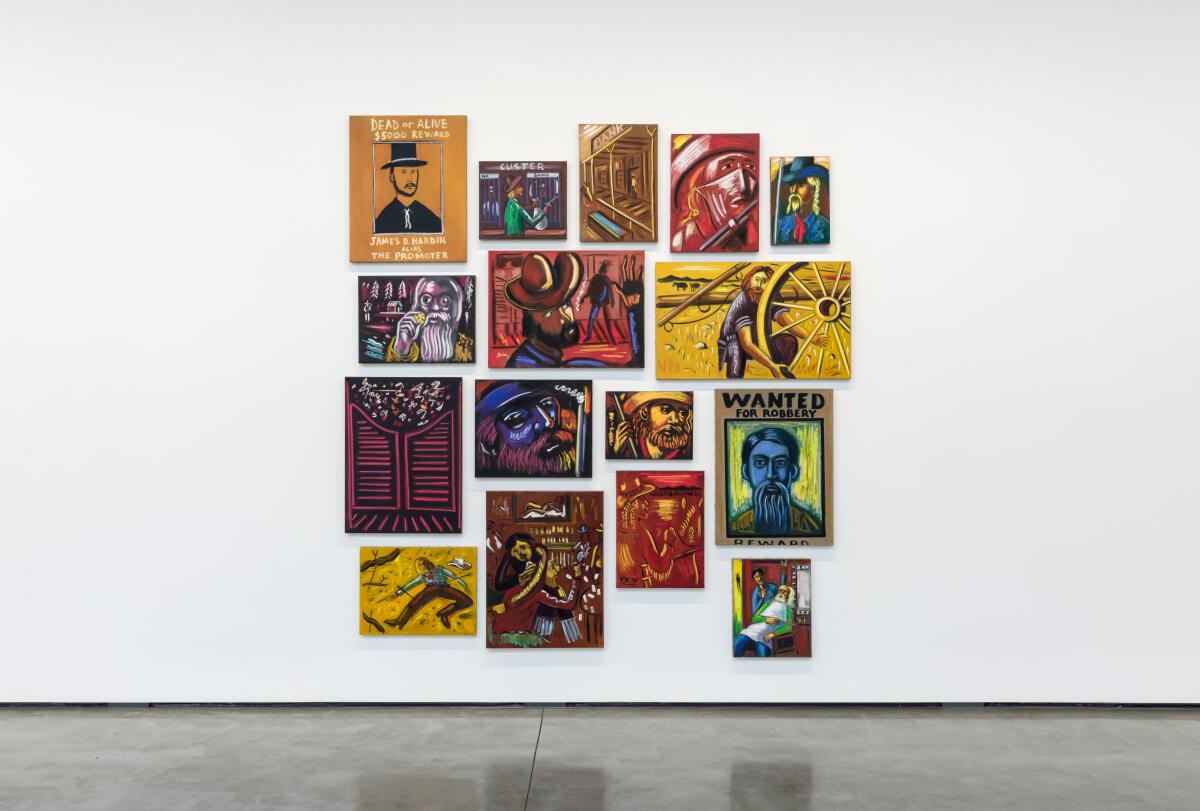
A pair of paintings depicting a hot dog and a chorizo platter in sickeningly garish colors show an artist who likes playing with his food. (He crafts faces out of mustard and jalapeños.) They also serve as his observations on the ways in which food travels across cultures.
“If you think of Mexican food ... it’s chiles, it’s tortillas de maíz, it’s carnitas, aguacates [avocados],” he says. “These are all Indigenous foods. I find it interesting that it’s taken ahold of the society. Everybody creates or digs Mexican food. But what they are really digging is Indigenous food.
“Could it be that Indigenous philosophy is spread through the food?” he asks. “That’s an interesting premise.”

What do paintings of hot dogs and the Black Hills have in common? Guerrero’s perceptive eye. These are works that are less about the objects than the ways in which they are perceived. The paintings, taken together, function as a humorous ethnography of our culture — the American one, the Mexican one, the Indigenous one and the ways in which they fuse and collide in this place we now call Southern California.
“Raul Guerrero: Fata Morgana” is on view at David Kordansky Gallery through Aug. 28; davidkordansky.com.
Art report
At the California African American Museum, L.A.-born, New York-based artist Sanford Biggers has a solo show, “Codeswitch,” which explores quilting as material but also as a technique. He reassembles found quilts in ways that play on tradition. “Throughout the show, there’s a sense of these additive moves being made up as the artist went along, rather than following a predetermined design,” writes Times art critic Christopher Knight. “They radiate pleasure in the making.”
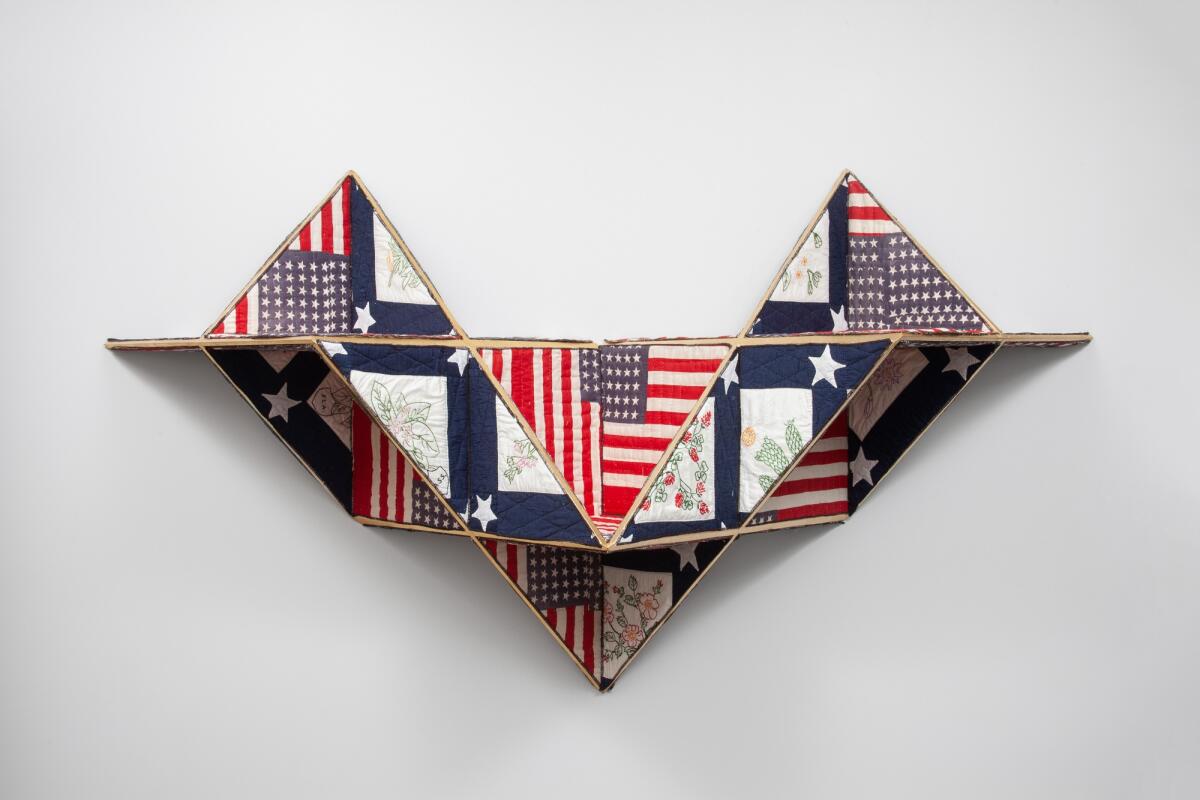
Design time
A 1960s bank building in Inglewood has been reborn as a new performance hall and rehearsal space for the Youth Orchestra Los Angeles courtesy of Frank Gehry. It’s a warm and unfussy 272-seat performance hall with 45-foot ceilings and acoustic design by Nagata Acoustics International. A handsome work of adaptive reuse, it helps preserve at least one aspect of Inglewood’s profile at a time of rising rents and gentrification. “It’s not necessary to build a bright, shiny object that everybody looks at,” Gehry tells me. “The programming and the effect on the community — that is the issue.”
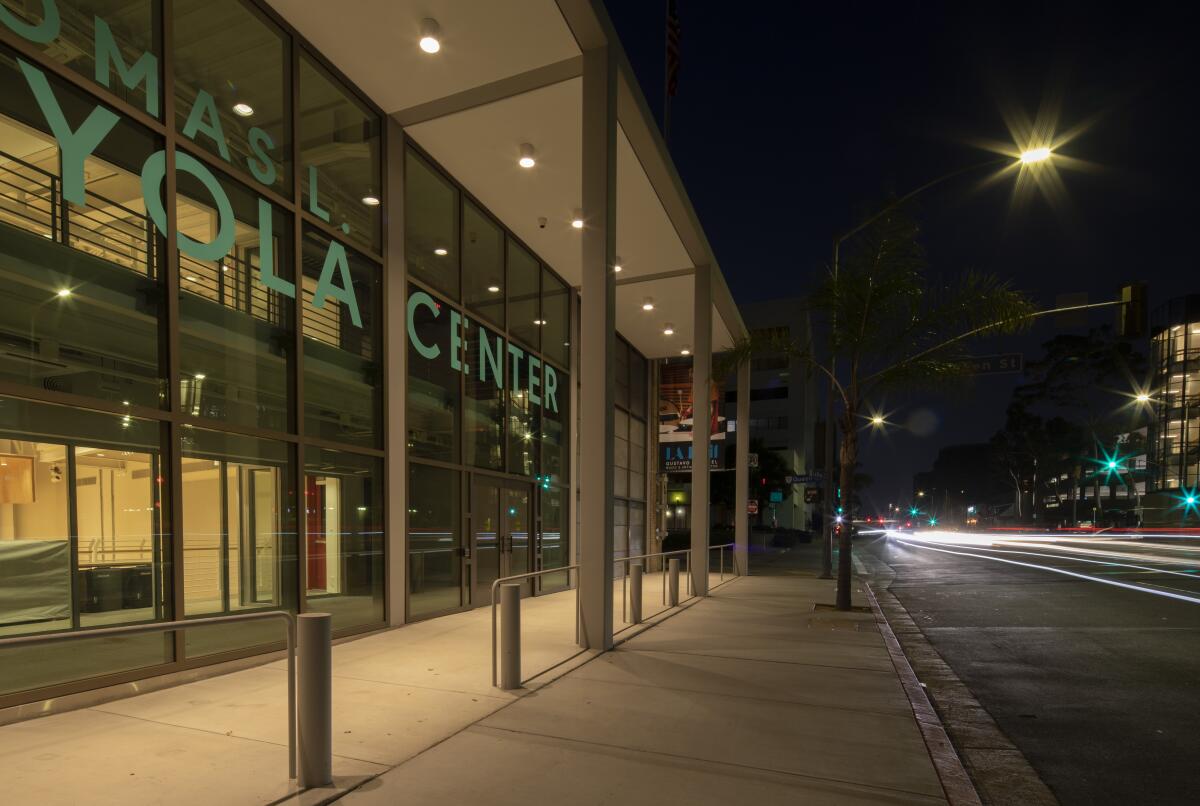
Performance notes
At the age of 83, stage and theater actress Annie Korzen (“Pen15,” “Oliver Beene” and “Seinfeld”) has developed a new fanbase by speaking her mind on TikTok. The Times’ Jessica Gelt sat down for an interview with Korzen, along with her pal Mackenzie Morrison, 30, who assists Korzen with tech and advice on how to stay relevant with the youngs. Reports Gelt: “Before TikTok, Korzen thought she knew her fan base: ‘middle-aged or older college-educated people, mostly women, mostly Jews.’ On TikTok, her followers represent all ages and a variety of races and ethnicities.”
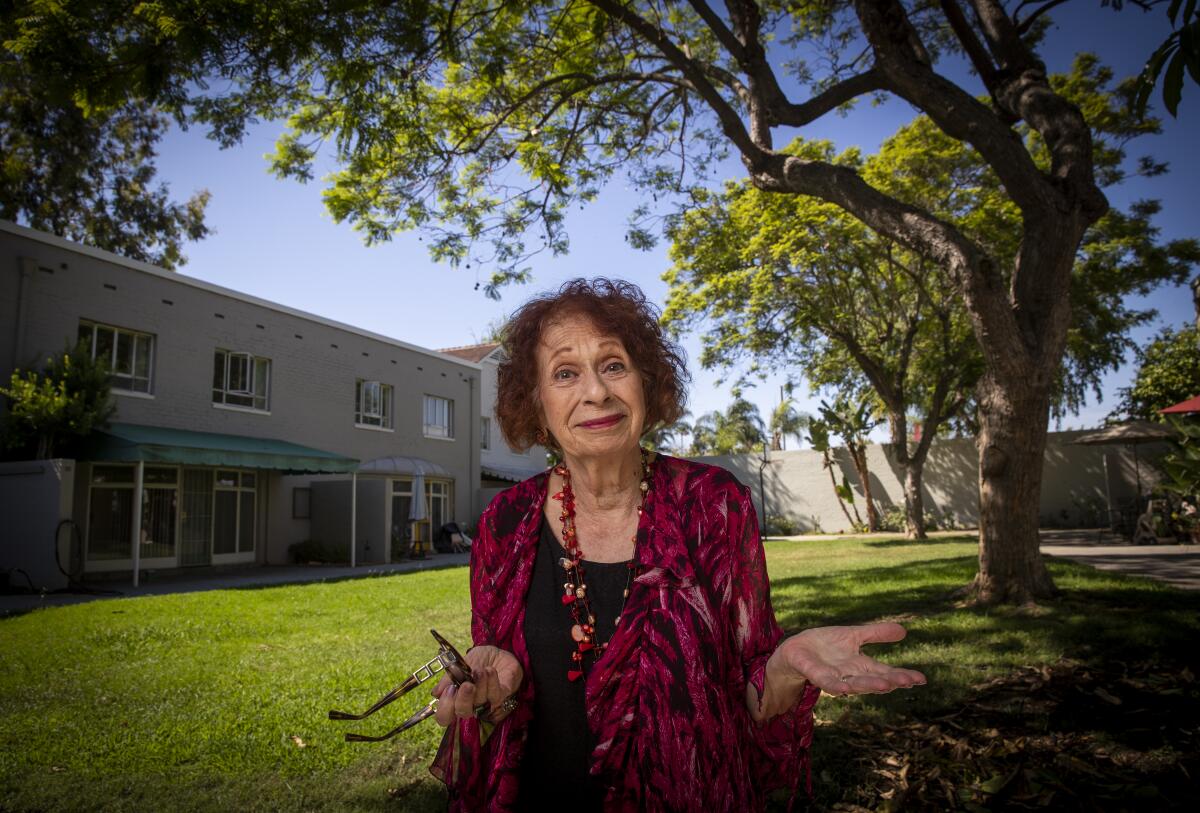
The COVID-19 Delta variant is throwing a wrench into the theater community’s best-laid plans. Taylor Mac’s “Joy and Pandemic,” which was set to debut at the Magic Theater in San Francisco next month, has been postponed indefinitely. (Ironically, the work is set during the 1918 flu pandemic.) Berkeley Repertory Theatre has also postponed its schedule — a world premiere of “The Ripple, the Wave That Carried Me Home.” This pushes the theater’s reopening to November.
Pairings
Sometimes reading a story becomes more meaningful after reading another that informs it.
I’ve been enjoying artist Pablo Helguera‘s newsletter, “Beautiful Eccentrics,” which consists of erudite dispatches on a range of cultural subjects. In an essay published last month, titled “Unelected Affinities,” he talks about how objects — including works of art that go unacknowledged by gatekeepers — can nonetheless turn into “the signifiers of a period.”
That essay shaped my reading of a recent report by Times Middle East bureau chief Nabih Bulos. In it, he explores the one-year anniversary of the ammonium nitrate blast in Beirut, the third-largest non-nuclear explosion in history. It also leveled a set of grain silos at the port that served as improvised symbols of the country’s resilience. “They were like the pyramids, like the Eiffel Tower of Beirut,” artist Lamia Ziade tells Bulos. “Every time I passed them, I would think how lucky we were to have this sentinel, these silos, protecting us.”
A year later, they sit in a state of destruction and decay.
Enjoying this newsletter? Consider subscribing to the Los Angeles Times
Your support helps us deliver the news that matters most. Become a subscriber.
There are two other pieces I read recently that also offer interesting resonances.
The first is the New Yorker‘s recent profile of landscape architect Kate Orff. A founder of SCAPE, Orff and her team are known for devising nature-based designs to help mitigate the effects of climate change. Her ideas first came to wide public attention in the 2010 exhibition “Rising Currents: Projects for New York’s Waterfront” at the Museum of Modern Art. At the time, Orff wanted to reinsert oyster beds into New York Bay — a process she referred to as “oyster-tecture.”
Oysters had once been plentiful in New York’s waters, but over the decades had been dredged to make way for shipping lanes. This removed a line of defense during deadly storm surges, such as the one that accompanied Hurricane Sandy, which made landfall in 2012.
Back in 2010, putting oysters back in the city’s waterways seemed like it stood a snowball’s chance in hell of getting implemented. But as the New Yorker’s Eric Klinenberg reports, that is exactly what’s happening now.

That story pairs well with this beautifully illustrated report by my colleague Rosanna Xia, about how some California coastal communities are trying to re-wild beach areas, restoring sand dune ecosystems that function as critical buffers against rising sea levels. Currently, beach dunes are often “groomed” (a.k.a. raked and flattened) for the benefit of coastal development and beachgoers. Some scientists are saying it’s time to un-groom them.
Together, both reports tell an interesting story about the ways in which the designers of the future may build: with oysters and sand.
Essential happenings
The Delta variant is making outdoor events more appealing than ever — and The Times’ Matt Cooper has some good ones in his weekly events round-up, including a production of “The Tempest” at the Griffith Park Free Shakespeare Festival and a site-specific performance by the Heidi Duckler Dance Company on the Wallis’ outdoor stage.
If you happen to be running around Koreatown, don’t miss Gabriela Ruiz‘s installation, “Grounding, Prevent from Flying,” at the diminutive new art space LaPau Gallery. (It’s in the same ramshackle, two-story building as Commonwealth and Council.) At LaPau, Ruiz has transformed the space — which is literally the size of a very large closet — into a riotous, color-saturated immersive experience that is a little bit like stepping into another dimension. Think of it as a mysterious trapdoor that leads to wonders beyond.
“Grounding, Prevent from Flying” is on view at LaPau Gallery through Aug. 21; lapaugallery.com.
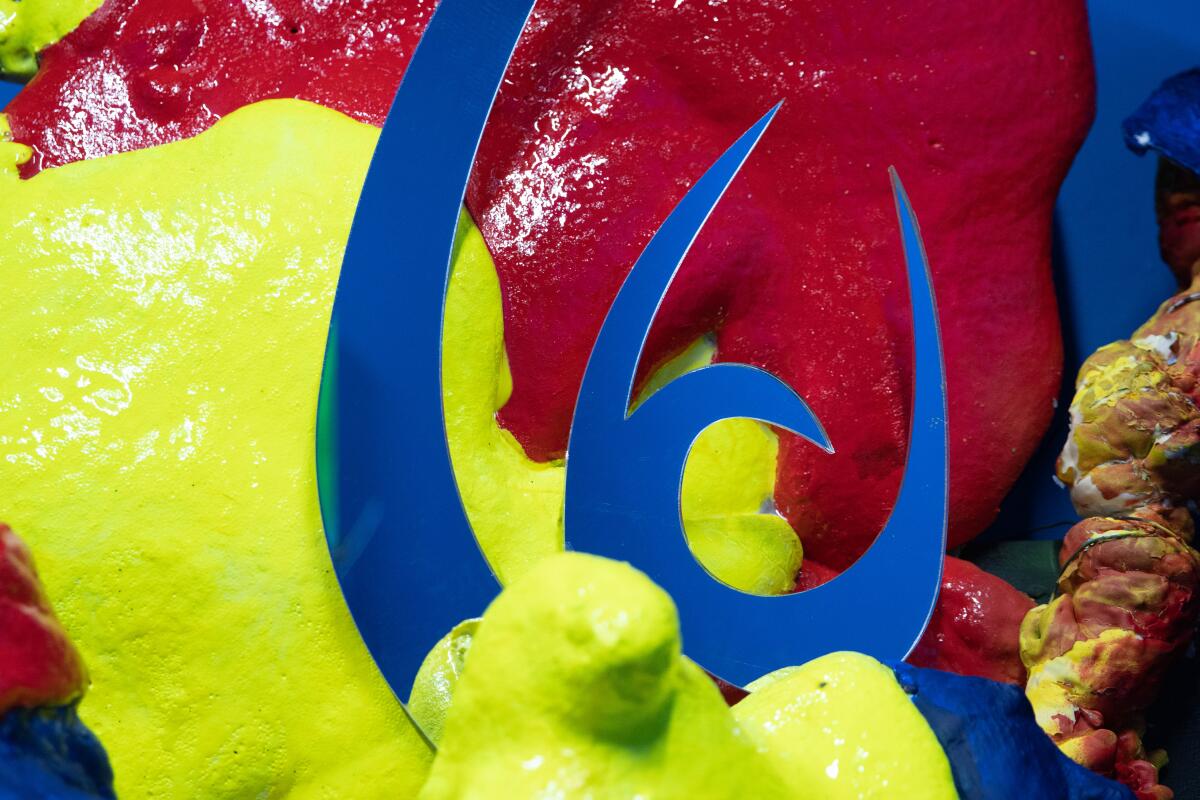
Entering its final weekend is “Intergalactix: Against Isolation / Contra el Aislamiento, an intriguing group exhibition at Los Angeles Contemporary Exhibitions (LACE) organized by curator Daniela Lieja Quintanar, featuring work that explores borders of a physical and psychological nature. This includes compelling work by artists such as Beatriz Cortez, Tanya Aguiñiga and Cog*nate Collective.
Particularly worthwhile is a suite of videos by Fire Theory, a collective of artists that came together in El Salvador and now operates internationally. This includes the beautiful and haunting “El sonido del viento en las tierras de nadie (The sound of the wind on no one’s lands),” 2020-21, by Melissa Guevara and Ernesto Bautista, which features audio of people discussing their motives for immigrating against images of stark desert landscapes, along with some poetic observations about the nature of those landscapes.
Most riveting was an installation film by Bautista. “Teatro del desencuentro (Theater of Missed Connections),” from 2018-21, centers on the story of a group of young children trapped in a cage. There they discuss migration, violence, the American dream and have some intensely metaphysical conversations about their condition.
“Are we dead or alive?” asks a squeaky-voiced child early on in the piece.
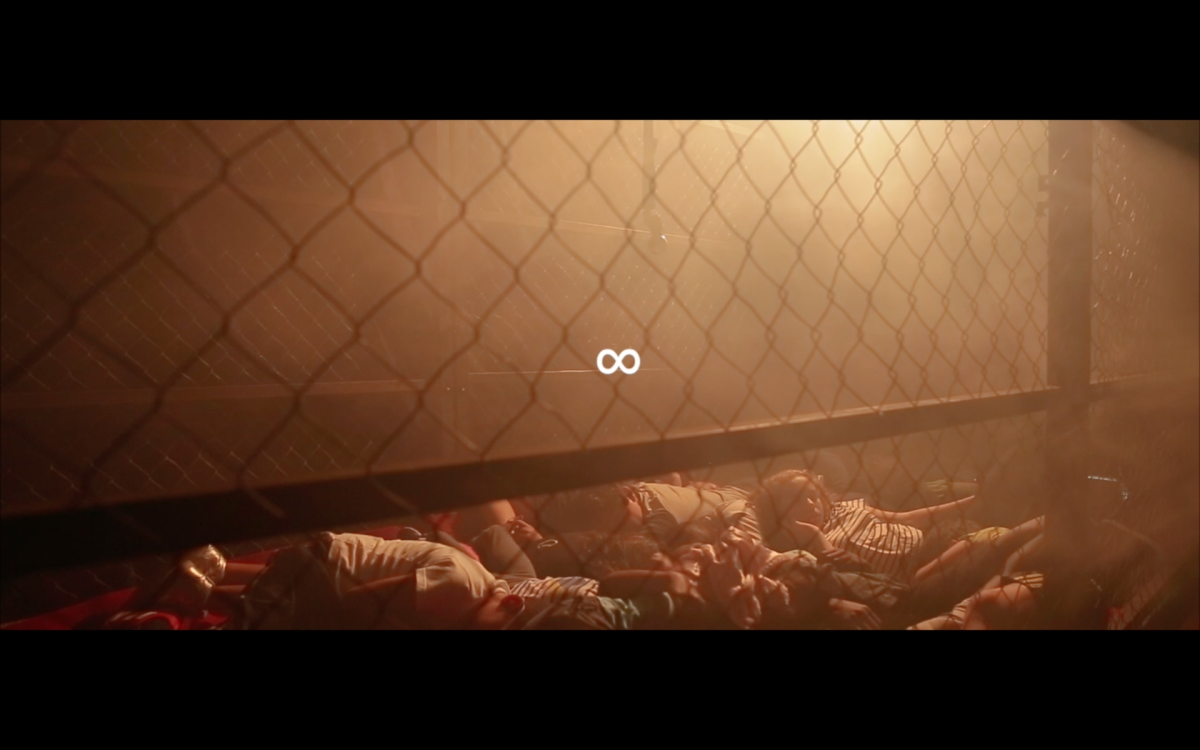
Interestingly, this work of performance was not written by adults. The dialogue was inspired by a series of discussions and improvisations staged at a theater workshop with children in Tegucigalpa. Moreover, large portions of the video are filmed at angles that feel more like surveillance than cinema. It is surreal and unsettling — made more so by the fact that child detention has not ended with the advent of the Biden administration.
Bautista’s piece is intended to be seen as part of a 360-degree video installation. But for reasons of space, it is presented at LACE as a single-channel video. Here’s hoping some enterprising museum curator picks up on it and gives this theater of the oppressed the space and treatment it so richly deserves.
“Intergalactix: against isolation/contra el aislamiento” is on view at LACE through Sunday; welcometolace.org. Melissa Guevara and Ernesto Bautista’s videos will be available for viewing on LACE’s website through Aug. 31.
Passages
Hung Liu, an Oakland-based painter known for creating work that explored identity, migration and the Maoist culture she grew up in, in her native China, is dead at 73. This comes just as the artist opened a solo show at San Francisco’s de Young Museum.
In other news
— A logical next step: New York’s Immersive Van Gogh experience is partnering with a cannabis brand for some special events.
— How the new documentary, “The Lost Leonardo,” tracks the rise and disappearance of the mysterious “Salvator Mundi” attributed to Leonardo Da Vinci.
— A great profile of Ishmael Reed, the writer and satirist who wrote the play “The Haunting of Lin-Manuel Miranda,” a critique of the founding father mythology that saturates “Hamilton.”
— How museums are rethinking their roles in the era of climate change, courtesy of new grants from the Frankenthaler Foundation.
— Speaking of climate: A typhoon swept a Yayoi Kusama sculpture into the sea and I’m imagining the countless cinematic possibilities of floating pumpkin sculptures in a Hollywood apocalypse picture.
— In South Korea, how one hospital has designed a mobile, contactless COVID-19 testing booth.
— Plus: Why isn’t the COVID-19 vaccine card designed to fit in our wallet?
— Variations on a theme: what the White House could have looked like.
And last but not least ...
Café Tacvba frontman Rubén Albarrán recently teamed up with San Diego band the Color Forty Nine on the song “What would I know? — ¿Yo que sé?” Tijuana artist Hugo Crosthwaite (who I have interviewed in the past) designed the animations for their video and they are terrific.
The biggest entertainment stories
Get our big stories about Hollywood, film, television, music, arts, culture and more right in your inbox as soon as they publish.
You may occasionally receive promotional content from the Los Angeles Times.




